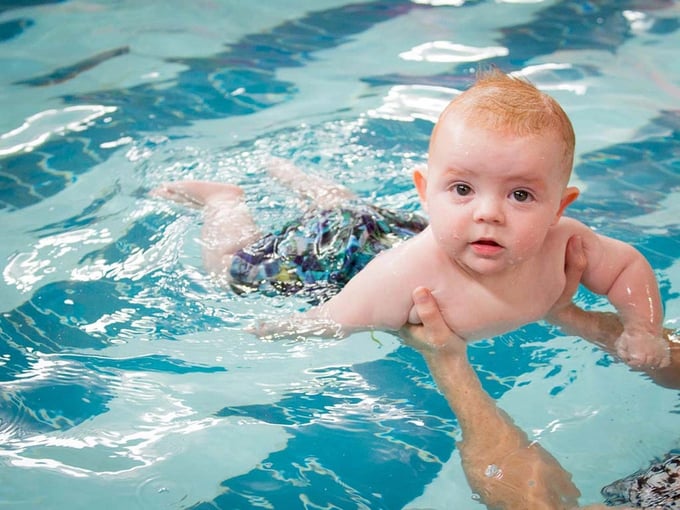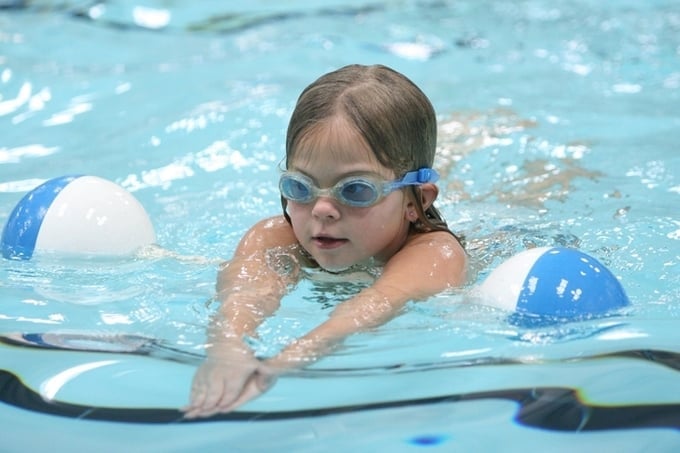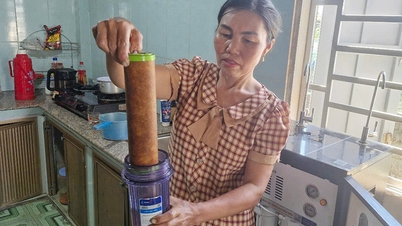Swimming can support the comprehensive development of children, and at the same time help cool down the summer. Previously, there was a trend of many families bringing babies under 6 months old to the swimming pool with the desire to help their children learn to swim as soon as possible. This method is controversial due to lack of scientific evidence.
In addition, children cannot regulate their body temperature as well as adults, and can get infections if they swim in public pools. So what is the most suitable age for children to start learning to swim?

Illustration
The American Academy of Pediatrics recommends that children begin swimming lessons at age 1, provided they have a professional instructor. In fact, there is no evidence that swimming lessons reduce the risk of drowning in children this age. However, exposing children to swimming positions and more activities in open water provides opportunities for parents and children to play together, helping them become comfortable in the water.
Letting children learn to swim early will help their respiratory and circulatory systems become healthier, which is good for their height development, helps them develop intelligence, eat and sleep better, and form positive reflexes.
Before enrolling a 1-year-old in swimming lessons, parents need to consider their child's emotional maturity, physical development, and comfort in water to determine whether they are ready to learn to swim.
It is best for families to start by using a toddler pool or taking their child to the shallowest part of the pool. Because children are more susceptible to hypothermia, they should swim in a separate pool with water that is around 90 degrees Fahrenheit.
Parents may even want to enroll their children in parent-child swimming classes to instill water safety habits and provide a fun interactive experience for parent and child.
If the child is anxious, the family should use a gentle, calm tone to reassure the child, helping the child feel more secure and relaxed. Eventually, the child will need to practice basic swimming techniques, such as moving the arms and kicking the legs, and when they are confident and proficient, gradually reduce the support buoy. The family should not let the child learn to dive or submerge the infant while swimming, because the child is not ready to hold his breath underwater.
Parents should let their children practice swimming early in the morning if they need to use a public swimming pool. The reason is that the sound of splashing water and the noise from the crowd can make children panic, making it difficult for them to learn to swim. In addition, families also need to focus on spending time teaching their children. The sunlight in the early morning is less harsh, reducing skin damage. When children feel uncomfortable, families should stop immediately, should not force children to learn to swim; if children are afraid of water, families should wait 1 month and then try again.
When enrolling children in swimming lessons, families should prioritize instructors who not only teach swimming techniques but also focus on water survival skills. Avoid swimming in pools that are chlorinated, as this can increase the risk of lower respiratory infections and allergies.

Illustration
By the time children are older, between the ages of 3 and 5, most children are ready to learn to swim and can learn essential skills such as floating, treading water, and finding escape routes.
Children can then refine these skills and learn practical swimming strokes. However, remember that learning to swim does not make children “drowning-proof”; instead, teaching “aquacompetence” skills helps children feel comfortable in the water and can help them if they get into trouble with the water.
At this point, parents should seek swimming lessons from qualified, trained instructors who should also have a First Aid certificate. They should teach children never to swim without adult supervision, what to do and how to get out if they accidentally fall into the water.
Source


![[Photo] Prime Minister Pham Minh Chinh receives a bipartisan delegation of US House of Representatives](https://vphoto.vietnam.vn/thumb/1200x675/vietnam/resource/IMAGE/2025/5/28/468e61546b664d3f98dc75f6a3c2c880)

![[Photo] 12th grade students say goodbye at the closing ceremony, preparing to embark on a new journey](https://vphoto.vietnam.vn/thumb/1200x675/vietnam/resource/IMAGE/2025/5/28/42ac3d300d214e7b8db4a03feeed3f6a)

![[Photo] Vietnamese and Hungarian leaders attend the opening of the exhibition by photographer Bozoky Dezso](https://vphoto.vietnam.vn/thumb/1200x675/vietnam/resource/IMAGE/2025/5/28/b478be84f13042aebc74e077c4756e4b)










































































Comment (0)